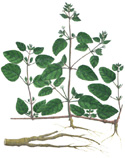| Latin Names | Boerhavia diffusa Linn. syn.Boerhaavia repens Linn. (Nyctaginaceae) |
| English Name | Spreading hogweed |
| Sanskrit Names | Punarnava, Rakta Punarnava, Shothagni |
| Hindi Names | Lal Punarnava, Santh |
 Distribution: Abundantly occurrs as a weed throughout India, up to an altitude of 2,000 m in the Himalayas. It is also cultivated to some extent in West Bengal. Habit: A diffusely branched, pubescent or glabrous, prostrate herb. The root-stock is stout, fusiform and woody; the stems are creeping often purplish, swollen at the nodes; the leaves are long-petioled, ovate or oblong-cordate, entire or sinuate; the flowers are red, pink or white, in small umbels; the fruits are ovate, oblong, pubescent, five-ribbed, glandular anthocarps. Principle constituents: The roots contain the rotenoids boeravinones AI, BI, C2, D, E and F besides the new dihydroisofurenoxanthin and borhavine. Indications: The roots are credited with anti-convulsant, analgesic, alzative, laxative, and expectorant properties. They also have diuretic and hepatoprotective actions. Product range: Abana, Bonnisan, Diabecon, Geriforte, Lukol, Styplon, Menotab, EveCare, V-gel |
|